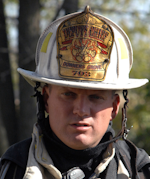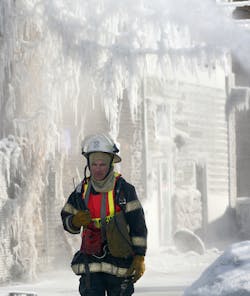With winter conditions soon approaching, the fire service is left to contend with additional demands due to heavy snowfall and extreme temperature conditions. The hazards and complications of winter firefighting can be overcome by firefighters developing a basic understanding of those hazards and conditions and properly preparing for them beforehand.
Response Safety
Year after year, responding to and from emergency calls is one of the leading activities being performed in studies of firefighter fatalities. Cold weather, contributing to extreme road conditions, will only increase the amount of risk that we are exposed to.
Preparing for winter response starts with making certain that our apparatus is ready and in top operating condition (as it should be at all times). In particular, driver/operators should make certain that they are familiar with the operations of window defrosters, heat vents and brake retarders on their particular apparatus as well as their department's guidelines for operating a "dry" versus "wet" pump during winter months.
Coating the threads of any fittings or port caps with straight antifreeze will help prevent them from freezing without damaging any gaskets and should performed as needed in daily vehicle checks. A spray bottle can be filled with antifreeze and kept on the rig for this purpose.
Increased stopping distances, decreased visibility and unpredictable actions of civilian motorists can all be expected in extreme weather and will have a negative impact on response. Routes of travel to alarms will need to take snow/ice removal and accessibility to the incident into consideration.
Is there a plan in place to have the public works department assist the fire department with snow removal resources in the event of an extreme winter storm? Discussing this and having a plan in place prior to needing it will definitely be advantageous.
Taking the proper precautions necessary in extreme weather is going to cause extended response times. How will this influence the actions of the first due companies? The important point to remember - the fire department is of no value unless it is able to arrive on scene safely.
Fireground Concerns
Once having arrived on scene, the company officer will have to make critical decisions on the commitment of apparatus. Questions that need to be considered: are tactical positions attainable or are they blocked by snow banks? Are additional lengths of hose needed to be added to pre-connected lines to make it to the building? Can personnel access all sides of the building and are there any hazards or obstacles present that are not visible due to snow or ice such as stairs, drop offs or in ground swimming pools?
Are fire hydrants visible and accessible - both prior to and after streets are plowed? Firefighters should ensure hydrants are accessible after severe storms before they freeze by routinely checking on them and clearing snow from them. Attaching flags or a marking device that sticks up a ways in the air can also make it easier to spot a hydrant covered by snow.
Another solution that has been successful is a program called "Pluggie's Pals" where school children and their parents work with the fire department to make certain that a fire hydrant near their property is distinguished with a marker pole prior to a winter storm and are also given the responsibility of clearing their assigned fire hydrant of snow after a storm- in return, a picnic is often held for the children and attended by firefighters in the spring to say thank you to the kids.
Once finding the hydrant, is it usable or frozen? Small hand held propane torches can be of great use to free frozen hydrant caps or hose couplings during cold weather and should be placed on the rig for winter months.
Once committed and flowing water, engine companies will need to keep water moving in some manner to keep hoselines, ladder pipes, valves and pumps from freezing solid. Static water will freeze readily as we already know at 32 degrees Fahrenheit but if enough movement is provided, water will not freeze spontaneously until the ambient temperature reaches -40 degrees Fahrenheit.
Water as we are aware exists in the states of a solid (ice), liquid, and a gas (steam). The major factor that differentiates these three states is the motion of the molecules that comprise water. When heat (as in the form of friction caused by movement) is added, its molecules will move faster and freely interact. As water freezes, the movement of molecules slow down and begin to align in a crystal like structure resulting in ice. As water freezes, its density (or mass per unit volume) will also increase until it reaches a solid crystallized state. If water is constricted as in a hoseline or piping when this expansion of mass takes place, the pressure exerted can cause costly damage. For this reason, keep nozzles, deck guns, ladder pipes etc. partially open with water flowing until ready to shut down and pack up. Hoselines and ladderpipes should be drained and picked up immediately when they stop flowing water and are no longer needed.
Injuries & Rehab
Slips and falls are another prevalent hazard during cold weather operations. The soles of many firefighting boots worn will become harder in colder temperatures preventing them from "gripping" the ground. Removable cleats or spikes that slip over boot soles can be advantageous in this situation.
Water on the ground from cold weather operations will also create an increased potential for slips and falls. Sodium Chloride or road salt is commonly carried on fire apparatus due to its ability to impede ice formation. Road salt is often applied to the ice once it is already formed. Unfortunately, the salt must first be dissolved before it can work effectively. Salt works by breaking chemical bonds and preventing water molecules from aligning in the crystal state that we talked about. If salt is applied before water freezes, it will be readily dissolved and will effectively lower the freezing point of the water. Sand can also be thrown onto the ground to improve traction.
Rehabilitation resources and additional alarms should be requested as soon as possible. The rehab location should get firefighters out of the elements, be located away from vehicle exhaust and concentrate on providing hydration through warm fluids.
One of the most overlooked ways of protecting ourselves from cold stress is through proper hydration. This needs to take place prior to responding to an incident to make certain that our body's systems are working at their best. Vital functions of our body will shut down when not properly hydrated. During work cycles it is recommended that a firefighter drink at least a quart of water per hour.
Firefighters will only be able to battle the elements for short periods of time in extreme weather due to stress and shorter work cycles should be adhered to. Turnout gear does not allow for effective heat dissipation and sweating from performing fireground activity can lead to shivering and lowering of the body core temperature. Body core temperatures falling below accepted levels can cause severe injury to firefighters without them even realizing what is happening to them. Stress from the cold decreases cognitive reasoning as well as focus.
Frost bite is caused by parts of the body being exposed to extreme cold. It can result from a very short time of exposure if cold enough. Fluids contained within exposed body part freeze causing blood vessel damage and necrosis or death of tissue in the affected area. Several factors contribute to the severity of frostbite
- the temperature to which the exposed part is exposed
- the length of time which the body part is exposed
- the condition of clothing covering the exposed area (is it wet or dry?)
Most often the hands, feet, ears and face of a firefighter are most prone to frostbite. Frostbite will appear as changes in skin appearance as discoloration (white or gray) and will be accompanied by numbness and stiffness to the affected area. Often times a patient experiencing frostbite will not even realize it due to accompanying numbness. The best way to prevent frostbite is to protect skin from direct exposure to cold air. Firefighters should dress in layers of loose fitting clothes beneath their turnout gear. Materials of these clothes should allow evaporation of perspiration and not be restrictive as to compromise the body's circulation in helping to keep the body warm. Two pairs of socks and properly fitted footwear are also recommended.
Hypothermia results when the body core temperature falls below normal. Firefighters suffering from hypothermia will exhibit shivering, confusion, extreme fatigue and drowsiness.
The best way to prevent hypothermia is also to dress in layers beneath turnout gear and to keep moving when working on the fireground to maintain a good level of circulation. Firefighters should make certain to keep their heads covered with a hat or hood when working in cold weather. As much as 50 percent of the body's heat can be lost through the head and wearing a hat will help to minimize that loss.
Firefighters should also replace any wet clothing immediately as wet clothes will cool down the body's core temperature much quicker than air alone. Keeping a bag with a dry change of clothes, extra gloves, socks and hats on the apparatus is a good idea during winter months.
Structural Concerns & Equipment
In addition to the obvious fall hazards, ice will present other hazards and problems on the fireground.
As water is applied to a burning structure it will freeze and not run off. As more and more water is applied, ice will cause additional weight and stress on structural members increasing collapse potential.
Locks and halyards on ladders can become frozen making them inoperable or difficult to move. Aerial ladders can become caked with ice increasing weight loads on them resulting in failure or twisting of the ladder.
Cold weather can definitely take a toll on firefighters and the equipment that they use. With proper pre incident planning, training and awareness, the hazards of extreme winter weather firefighting can be reduced to allow safe operations on the fireground.
JEFFREY PINDELSKI, a Firehouse.com Contributing Editor, is a 20-year veteran and student of the fire service and is the deputy chief of operations with the Downers Grove, IL, Fire Department. Jeff is a staff instructor at the College of Du Page and has been involved with the design of several training programs dedicated to firefighter safety and survival. Jeff is the co-author of the text R.I.C.O., Rapid Intervention Company Operations. Jeff was host of the recent Preparing for Tomorrow's RIT Deployment Today podcast was a guest on the inaugural edition of the Training & Tactics Talk. View all of Jeff's articles and podcasts here. You can reach Jeff by e-mail at [email protected].

Jeffrey Pindelski
JEFFREY PINDELSKI is the Downers Grove, IL, Fire Department Chief (Ret.) and has been a student of the fire service for more than 30 years. He served as a chief officer for more than 15 years of his career, during which time he directly managed every aspect of the fire department at one time or another. Pindelski holds a master's degree in Public Safety Administration from Lewis University and earned a Graduate Certificate in Managerial Leadership and a bachelor's degree from Western Illinois University. He is the co-author of "R.I.C.O.- Rapid Intervention Company Operations" and was a revising author of the third edition of "Firefighter's Handbook." Pindelski presented at numerous fire service conferences and had more than 55 articles published in trade journals on various fire service-related topics. He is a recipient of Illinois' Firefighting Medal of Valor.






